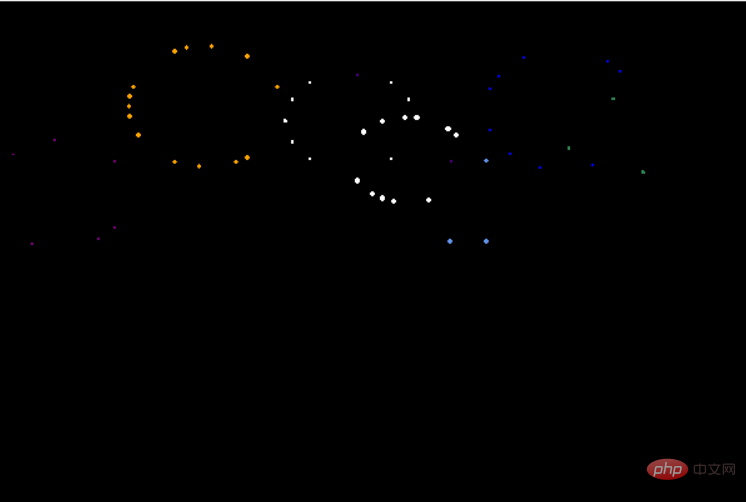如何用python画烟花
用python画烟花的方法:首先创建一个所有粒子同时扩大的二维列表;然后实现粒子范围扩大,以自由落体坠落;接着移除超过最高时长的粒子;最后循环调用保持不停。

用python画烟花的方法:
# -*- coding: utf-8 -*-
# Nola
import tkinter as tk
from PIL import Image, ImageTk
from time import time, sleep
from random import choice, uniform, randint
from math import sin, cos, radians
# 模拟重力
GRAVITY = 0.05
# 颜色选项(随机或者按顺序)
colors = ['red', 'blue', 'yellow', 'white', 'green', 'orange', 'purple', 'seagreen', 'indigo', 'cornflowerblue']
'''
particles 类
粒子在空中随机生成随机,变成一个圈、下坠、消失
属性:
- id: 粒子的id
- x, y: 粒子的坐标
- vx, vy: 在坐标的变化速度
- total: 总数
- age: 粒子存在的时长
- color: 颜色
- cv: 画布
- lifespan: 最高存在时长
'''
class Particle:
def __init__(self, cv, idx, total, explosion_speed, x=0., y=0., vx=0., vy=0., size=2., color='red', lifespan=2,
**kwargs):
self.id = idx
self.x = x
self.y = y
self.initial_speed = explosion_speed
self.vx = vx
self.vy = vy
self.total = total
self.age = 0
self.color = color
self.cv = cv
self.cid = self.cv.create_oval(
x - size, y - size, x + size,
y + size, fill=self.color)
self.lifespan = lifespan
def update(self, dt):
self.age += dt
# 粒子范围扩大
if self.alive() and self.expand():
move_x = cos(radians(self.id * 360 / self.total)) * self.initial_speed
move_y = sin(radians(self.id * 360 / self.total)) * self.initial_speed
self.cv.move(self.cid, move_x, move_y)
self.vx = move_x / (float(dt) * 1000)
# 以自由落体坠落
elif self.alive():
move_x = cos(radians(self.id * 360 / self.total))
# we technically don't need to update x, y because move will do the job
self.cv.move(self.cid, self.vx + move_x, self.vy + GRAVITY * dt)
self.vy += GRAVITY * dt
# 移除超过最高时长的粒子
elif self.cid is not None:
cv.delete(self.cid)
self.cid = None
# 扩大的时间
def expand (self):
return self.age <= 1.2
# 粒子是否在最高存在时长内
def alive(self):
return self.age <= self.lifespan
'''
循环调用保持不停
'''
def simulate(cv):
t = time()
explode_points = []
wait_time = randint(10, 100)
numb_explode = randint(6, 10)
# 创建一个所有粒子同时扩大的二维列表
for point in range(numb_explode):
objects = []
x_cordi = randint(50, 550)
y_cordi = randint(50, 150)
speed = uniform(0.5, 1.5)
size = uniform(1, 3)
color = choice(colors)
explosion_speed = uniform(0.2, 1)
total_particles = randint(10, 50)
for i in range(1, total_particles):
r = Particle(cv, idx=i, total=total_particles, explosion_speed=explosion_speed, x=x_cordi, y=y_cordi,
vx=speed, vy=speed, color=color, size=size, lifespan=uniform(0.6, 1.75))
objects.append(r)
explode_points.append(objects)
total_time = .0
# 1.8s内一直扩大
while total_time < 1.8:
sleep(0.01)
tnew = time()
t, dt = tnew, tnew - t
for point in explode_points:
for item in point:
item.update(dt)
cv.update()
total_time += dt
# 循环调用
root.after(wait_time, simulate, cv)
def close(*ignore):
"""退出程序、关闭窗口"""
global root
root.quit()
if __name__ == '__main__':
root = tk.Tk()
cv = tk.Canvas(root, height=400, width=600)
# 绘制一个黑色背景
cv.create_rectangle(0, 0, 600, 400, fill='black')
# cv = tk.Canvas(root, height=400, width=600)
# # 选一个好看的背景会让效果更惊艳!
# image = Image.open("./image.jpg")
# photo = ImageTk.PhotoImage(image)
#
# cv.create_image(0, 0, image=photo, anchor='nw')
cv.pack()
root.protocol("WM_DELETE_WINDOW", close)
root.after(100, simulate, cv)
root.mainloop()
实现效果图:

相关免费学习推荐:python视频教程

